 |
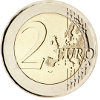 |
C o m m e m o r a t i v e
C o i n s |
||
| Germany | |||||||
The edge lettering of the German 2‐euro‐commemorative coins is : (Unity and justice and freedom) |
 |
||||||
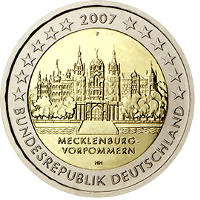 🔎
🔎 |
 |
Germany | 02 Feb. 2007 | Mecklenburg‐Western Pomerania (Schwerin Castle) 2nd coin in the Federal States series |
20001 20002 20005 |
31,245,630 |  |
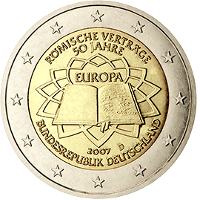 🔎
🔎 |
 |
Germany | 25 Mar. 2007 | 50th anniversary of the Signature of the Treaty of Rome |
20001 20002 20005 |
30,865,630 |  |
National characteristics : At the top are the words "Römische Verträge" (Treaties of Rome) and "50 JAHRE" (50 Years), below it is an illustration of the treaty with the words "EUROPA" (Europe), below that is the year "2007" and the country name "BUNDESREPUBLIK DEUTSCHLAND" (Federal States of Germany). The coin was minted by the German mint (A = Staatliche Münze Berlin in Berlin, D = Bayerisches Hauptmünzamt in Munich, F = Staatliche Münzen Baden‐Württemberg in Stuttgart, G = Staatliche Münzen Baden‐Württemberg in Karlsruhe or J = Landesbetrieb Hamburgische Münze in Hamburg) whose mint mark is to the right of the year. |
|||||||
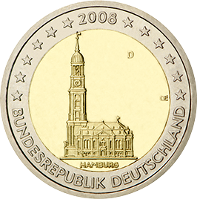 🔎
🔎 |
 |
Germany | 01 Feb. 2008 | Hamburg (St.‐Michaelis‐Church) 3rd coin in the Federal States series |
20001 20002 20005 |
30,513,630 |  |
‐ ‐ Originally, the St. Pauli landing piers were intended as a coin motif. Some 600,000 coins were accidentally minted by the Stuttgart mint (mint mark "F") with the old value side, which was valid from 2002 to 2006. |
|||||||
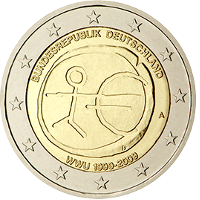 🔎
🔎 |
 |
Germany | 02 Jan. 2009 | 10 years of Economic and Monetary Union (EMU) |
20001 20002 20005 |
30,565,630 |  |
National characteristics : Above is the name of the issuing country "BUNDESREPUBLIK DEUTSCHLAND" (Federal States of Germany), the acronym of the occasion of issue below is "WWU". In the middle on the right is the mint mark of the German mint (A = Staatliche Münze Berlin in Berlin, D = Bayerisches Hauptmünzamt in Munich, F = Staatliche Münzen Baden‐Württemberg in Stuttgart, G = Staatliche Münzen Baden‐Württemberg in Karlsruhe or J = Landesbetrieb Hamburgische Münze in Hamburg). |
|||||||
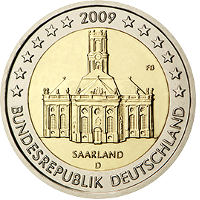 🔎
🔎 |
 |
Germany | 08 Feb. 2009 | Saarland (Ludwigs‐church in Saarbrücken) 4th coin in the Federal States series |
20001 20002 20005 |
30,940,630 |  |
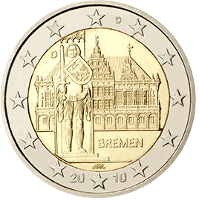 🔎
🔎 |
 |
Germany | 29 Jan. 2010 | Bremen (City Hall and Roland) 5th coin in the Federal States series |
20001 20002 20005 |
30,925,630 |  |
‐ ‐ Originally, only the Bremen town hall was to appear on the coin. |
|||||||
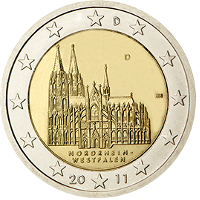 🔎
🔎 |
 |
Germany | 28 Jan. 2011 | North Rhine‐Westphalia (Cologne Cathedral) 6th coin in the Federal States series |
20001 20002 20005 |
30,925,000 |  |
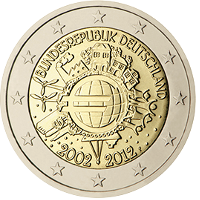 🔎
🔎 |
 |
Germany | 02 Jan. 2012 | 10 years Euro‐Currency |
20001 20002 20005 |
30,648,000 |  |
National characteristics : At the top of the coin is the name of the issuing country "BUNDESREPUBLIK DEUTSCHLAND" (Federal States of Germany). The German mint mark (A = Staatliche Münze Berlin in Berlin, D = Bayerisches Hauptmünzamt in Munich, F = Staatliche Münzen Baden‐Württemberg in Stuttgart, G = Staatliche Münzen Baden‐Württemberg in Karlsruhe or J = Landesbetrieb Hamburgische Münze in Hamburg) is located to the right of the year "2012". |
|||||||
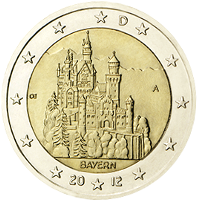 🔎
🔎 |
 |
Germany | 03 Feb. 2012 | Bavaria (Neuschwanstein Castle) 7th coin in the Federal States series |
20001 20002 20005 |
30,883,000 |  |
‐ ‐ The coin motif for Bavaria was originally intended to be the Munich Frauenkirche ("Cathedral of our Dear Lady"). |
|||||||
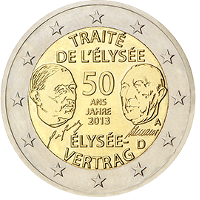 🔎
🔎 |
 |
Germany | 22 Jan. 2013 | 50 Year anniversary of the Élysée‐Treaty (Fanco‐German Friendship) Issued jointly by France and Germany |
20001 20002 20005 |
11,585,000 |  |
On the German coin, the mint mark of the German mint (A = Staatliche Münze Berlin in Berlin, D = Bayerisches Hauptmünzamt in Munich, F = Staatliche Münzen Baden‐Württemberg in Stuttgart, G = Staatliche Münzen Baden‐Württemberg in Karlsruhe or J = Landesbetrieb Hamburgische Münze in Hamburg) is located to the right above the signature, below which is the country abbreviation "D" (for Deutschland / Germany). |
|||||||
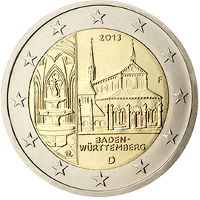 🔎
🔎 |
 |
Germany | 01 Feb. 2013 | Baden‐Württemberg (Maulbronn Monastery) 8th coin in the Federal States series |
20001 20002 20005 |
30,845,000 |  |
‐ ‐ Originally the Heidelberg Castle was intended as the motif for Baden‐Württemberg's commemorative coin, but when the UNESCO World Conference in July 2005 failed to recognise it as a World Heritage Site, the design was changed. |
|||||||
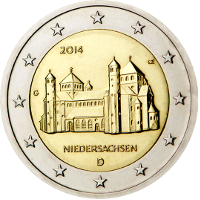 🔎
🔎 |
 |
Germany | 06 Feb. 2014 | Lower Saxony (St. Michael's church in Hildesheim) 9th coin in the Federal States series |
20001 20002 20005 |
30,799,300 |  |
‐ ‐ Lower Saxony's coin motif was originally intended to be the New Town Hall in Hanover. |
|||||||
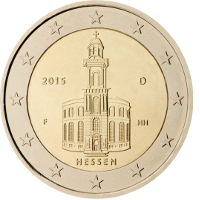 🔎
🔎 |
 |
Germany | 30 Jan. 2015 | Hesse (Paul's church in Frankfurt upon Main) 10th coin in the Federal States series |
20001 20002 20005 |
30,767,100 |  |
‐ ‐ The motif of the coin of Hesse was originally intended to be the Römer (city hall) in Frankfurt upon Main. |
|||||||
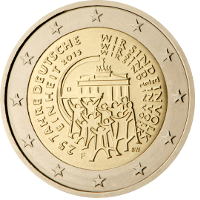 🔎
🔎 |
 |
Germany | 30 Jan. 2015 | 25th anniversary of German Reunification |
20001 20002 20005 |
30,517,100 |  |
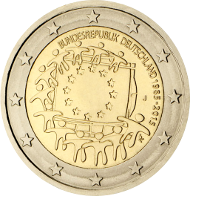 🔎
🔎 |
 |
Germany | 05 Nov. 2015 | 30 years EU‐Flag |
20001 20002 20005 |
30,125,000 |  |
National characteristics : Above is the name of the issuing country "BUNDESREPUBLIK DEUTSCHLAND" (Federal States of Germany), followed by the dates "1985‐2015". The German mint mark (A = Staatliche Münze Berlin in Berlin, D = Bayerisches Hauptmünzamt in Munich, F = Staatliche Münzen Baden‐Württemberg in Stuttgart, G = Staatliche Münzen Baden‐Württemberg in Karlsruhe or J = Landesbetrieb Hamburgische Münze in Hamburg) is shown on the right. |
|||||||
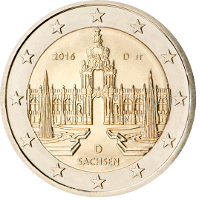 🔎
🔎 |
 |
Germany | 05 Feb. 2016 | Saxony (Zwinger Palace in Dresden) 11th coin in the Federal States series |
20001 20002 20005 |
30,677,600 |  |
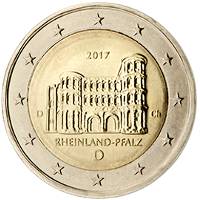 🔎
🔎 |
 |
Germany | 03 Feb. 2017 | Rhineland‐Palatinate (Porta Nigra in Trier) 12th coin in the Federal States series |
20001 20002 20005 |
30,616,300 |  |
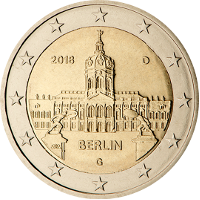 🔎
🔎 |
 |
Germany | 30 Jan. 2018 | Berlin (Charlottenburg Palace) 13th coin in the Federal States series |
20001 20002 20005 |
36,636,500 |  |
‐ ‐ Originally the Reichstag building was to be depicted on the coin. |
|||||||
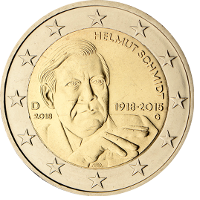 🔎
🔎 |
 |
Germany | 30 Jan. 2018 | 100th birthday of Helmut Schmidt |
20001 20002 20005 |
30,621,000 |  |
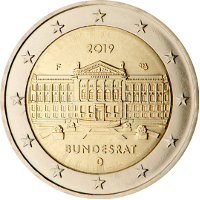 🔎
🔎 |
 |
Germany | 29 Jan. 2019 | 70 years of the Bundesrat (Prussian manor house in Berlin) 14th coin in the Federal States series |
20001 20002 20005 |
30,507,300 |  |
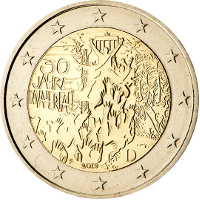 🔎
🔎 |
 |
Germany | 10 Oct. 2019 | 30th anniversary of the fall of the Berlin Wall Joint issue of Germany and France |
20001 20002 20005 |
30,297,000 |  |
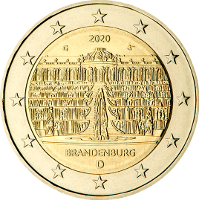 🔎
🔎 |
 |
Germany | 28 Jan. 2020 | Brandenburg (Sanssouci Palace in Potsdam) 15th coin in the Federal States series |
20002 20007 20008 |
30,567,500 |  |
 🔎
🔎 |
 |
Germany | 08 Oct. 2020 | 50th anniversary of the Warsaw kneeling |
20002 20007 20008 |
30,350,000 |  |
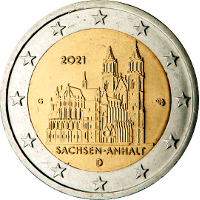 🔎
🔎 |
 |
Germany | 26 Jan. 2021 | Saxony‐Anhalt (Magdeburg Cathedral) 16th coin in the Federal States series |
20002 20007 20008 |
30,433,900 |  |
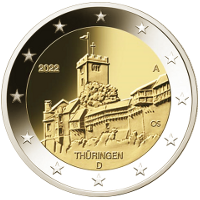 🔎
🔎 |
 |
Germany | 25 Jan. 2022 | Thuringia (Wartburg Castle) 17th coin in the Federal States series |
20003 20005 |
30,424,900 |  |
 Work in progress |
|||||||
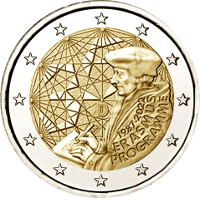 🔎
🔎 |
 |
Germany | 01 Jul. 2022 | 35th anniversary of the Erasmus Program |
20003 20005 20009 |
17,265,000 |  |
National characteristics : The country abbreviation "D" (Germany) is placed centrally below the centre line. The quarter circle at the bottom right has three lines; below the commemorative period, is the issue occasion "ERASMUS PROGRAMME" (in English). At the bottom on the left sleeve is the German mint mark (A = Staatliche Münze Berlin in Berlin, D = Bayerisches Hauptmünzamt in Munich, F = Staatliche Münzen Baden‐Württemberg in Stuttgart, G = Staatliche Münzen Baden‐Württemberg in Karlsruhe or J = Landesbetrieb Hamburgische Münze in Hamburg). |
|||||||
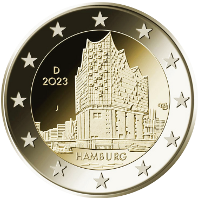 🔎
🔎 |
 |
Germany | 24 Jan. 2023 | Hamburg (Elbphilharmonie) 1st coin in the 2nd Federal States series |
20003 20005 20009 |
30,331,200 |  |
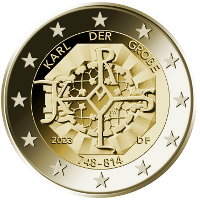 🔎
🔎 |
 |
Germany | 30 Mar. 2023 | 1275th Birthday of Charlemagne |
20003 20005 20009 |
20,275,000 |  |
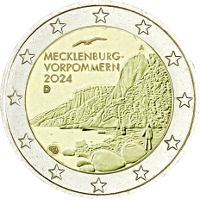 🔎
🔎 |
 |
Germany | 30 Jan. 2025 | Mecklenburg‐Western Pomerania (Königsstuhl) 2nd coin in the 2nd Federal States series |
20003 20005 |
30,000,000 |  |
 Work in progress |
|||||||
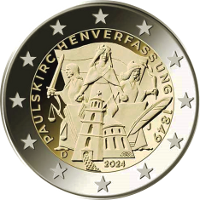 🔎
🔎 |
 |
Germany | 21 Mar. 2024 | 175th anniversary of the Paulskirche constitution |
20003 20005 |
20,000,000 |  |
 Work in progress |
|||||||
| References : | |||
| 20001 | Images taken with authorisation by the ECB ‐ Mail dated 20.Feb.2020 © "European Central Bank" |
20002 | Data mirrored from Wikipedia Page "2_euro_commemorative_coins" with friendly support of the guardians of that page. |
| 20003 | Images taken with authorisation by H....... Hamburg | 20004 | Coloured version of this Commemorative Coin in circulation EU‐legal‐technical specifications do not recongnise colour prints. The EU nevertheless tolerates them, as their numbers are very small and they are sold in special packs and therefor are very unlikely to be used as currency. |
| 20005 | enlarged Images taken with authorisation by Gerd Seyffert © "Gerd Seyffert 2021" |
20006 | Not Applicable |
| 20007 | Images taken by Münzen Kreuzberg © "Münzen Kreuzberg 2021" |
20008 | enlarged Images taken by Münzen Kreuzberg © "Münzen Kreuzberg 2021" |
| 20009 | Text with kind permission by Gerd Seyffert © "Gerd Seyffert 2023" |
20010 | Not Applicable |
 |



